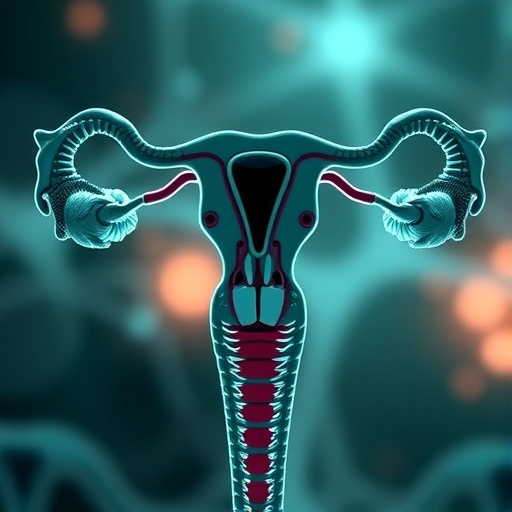In a groundbreaking study published in BMC Cancer, researchers have unveiled the pivotal role of Fibronectin type III domain containing 1 (FNDC1) in ovarian serous cancer, presenting it as a promising diagnostic marker and a potential target for tailored therapies. This discovery not only broadens our understanding of ovarian cancer pathophysiology but also opens new avenues for intervention strategies in one of the most challenging malignancies affecting women worldwide.
FNDC1, a member of the fibronectin type III domain protein family, has garnered significant attention due to its implication in the metastatic process of various cancers. Prior to this study, its specific involvement in ovarian serous cancer remained unexplored, leaving a crucial gap in oncological molecular profiling. The current investigation addresses this gap comprehensively by leveraging large-scale genomic datasets alongside in vitro validation to elucidate FNDC1’s diagnostic and therapeutic potential.
The researchers tapped into The Cancer Genome Atlas (TCGA) database to assess FNDC1 expression across multiple cancer types, uncovering a pronounced overexpression of FNDC1 in ovarian serous cancer samples. This bioinformatics-driven approach provided the initial evidence positioning FNDC1 as a potentially valuable biomarker for this malignancy, with implications for early detection and disease monitoring.
Delving deeper, the study employed an array of sophisticated bioinformatics techniques to dissect the molecular mechanisms underpinning FNDC1’s role in cancer progression. Key analyses included the investigation of immune cell infiltration patterns in relation to FNDC1 expression and its interplay with immune checkpoint molecules such as TNFSF4, shedding light on the complex tumor-immune microenvironment.
Remarkably, a strong positive correlation was found between FNDC1 and TNFSF4 expressions, suggesting their cooperative involvement in modulating T-cell responses within the tumor milieu. This finding is particularly important given the growing prominence of immunotherapy approaches that target immune checkpoints to restore or enhance anti-tumor immunity.
The study’s protein–protein interaction network analysis further highlighted that FNDC1 and TNFSF4 operate within shared signaling pathways essential for tumor survival and immune evasion strategies. Such intricate molecular links underscore the potential for dual-targeting therapies that disrupt this axis, thereby impeding cancer progression while amplifying immune-mediated tumor clearance.
Gene Ontology (GO) and Kyoto Encyclopedia of Genes and Genomes (KEGG) enrichment analyses provided additional layers of insight, identifying biological processes and pathways enriched in FNDC1-associated networks. These analyses revealed roles in cell adhesion, migration, and immune regulation, all critical facets of tumor metastasis and resistance mechanisms.
In parallel, gene set enrichment analysis illuminated broader oncogenic signaling cascades influenced by FNDC1 activity. Collectively, these results position FNDC1 not merely as a passive marker but as an active participant in orchestrating the malignant phenotype of ovarian serous cancer.
Beyond the computational realm, the team validated their findings through rigorous cell function experiments. These in vitro studies confirmed the elevated expression of FNDC1 in ovarian cancer cell lines compared to normal controls, supporting its candidacy as a diagnostic biomarker and reinforcing its functional relevance in tumor biology.
Notably, the research unveiled the potential therapeutic inhibition of FNDC1-mediated effects by austocystin D, a compound with established antitumor properties. This insight paves the way for exploring novel pharmacological agents that specifically target FNDC1-associated pathways, offering hope for improved treatment modalities.
The intricate link between FNDC1 and immune checkpoint molecule TNFSF4 also hints at combinatorial therapy strategies whereby immunomodulatory drugs could synergize with FNDC1-targeting agents. Such approaches could potentiate anti-tumor immune responses and overcome existing therapeutic resistance.
This discovery is particularly timelier as ovarian serous cancer continues to pose significant clinical challenges owing to late-stage diagnosis and limited effective treatments. The identification of FNDC1 as both a diagnostic and therapeutic target addresses a critical need for molecularly informed clinical tools.
While this study marks a defining step forward, further clinical validation and translational research are imperative to fully harness FNDC1’s potential. Future investigations into patient cohorts and the development of FNDC1-targeted therapeutics will be essential to move from bench to bedside.
In summary, the research spearheaded by Jiao and colleagues represents a seminal contribution to the field of oncology. By establishing FNDC1 as a diagnostic marker and uncovering its immunomodulatory roles, the study propels ovarian serous cancer research into a new era of precision medicine, offering renewed optimism for patients and clinicians alike.
As the scientific community continues to unravel the molecular underpinnings of cancer, discoveries such as these underscore the transformative power of integrative bioinformatics and experimental validation. The convergence of multi-omics data sets with cutting-edge laboratory techniques sets a precedent for future cancer research endeavors.
Ultimately, targeting FNDC1 and its associated pathways could revolutionize ovarian cancer management, providing tools for early detection, prognostic assessment, and effective targeted therapies. This multifaceted approach aligns with the overarching goals of improving survival outcomes and quality of life for patients afflicted by this devastating disease.
The findings shine a spotlight on the critical importance of exploring lesser-known molecular entities like FNDC1, reminding us that the cancer genome still harbors myriad secrets waiting to be deciphered. Continuous support for such exploratory research is key to fostering breakthroughs that can reshape clinical paradigms globally.
With the integration of FNDC1 into the diagnostic and therapeutic landscape, a new chapter unfolds in the fight against ovarian serous cancer — one defined by innovation, hope, and the relentless quest to outsmart this formidable adversary.
Subject of Research: FNDC1 as a diagnostic biomarker and therapeutic target in ovarian serous cancer
Article Title: Analysis of FNDC1 as a diagnostic marker and potential therapeutic target for ovarian serous cancer
Article References:
Jiao, H., Tian, J., Liu, Q. et al. Analysis of FNDC1 as a diagnostic marker and potential therapeutic target for ovarian serous cancer. BMC Cancer 25, 1595 (2025). https://doi.org/10.1186/s12885-025-14924-0
Image Credits: Scienmag.com
DOI: https://doi.org/10.1186/s12885-025-14924-0
Tags: bioinformatics in cancer researchcancer biomarker discoveryearly detection of ovarian cancerfibronectin type III domain proteinsFNDC1 ovarian cancer diagnosticsFNDC1 therapeutic targetgenomic datasets in oncologyintervention strategies for ovarian cancermetastatic ovarian cancer mechanismsovarian serous cancer researchtailored therapies for ovarian cancertumor profiling and FNDC1





